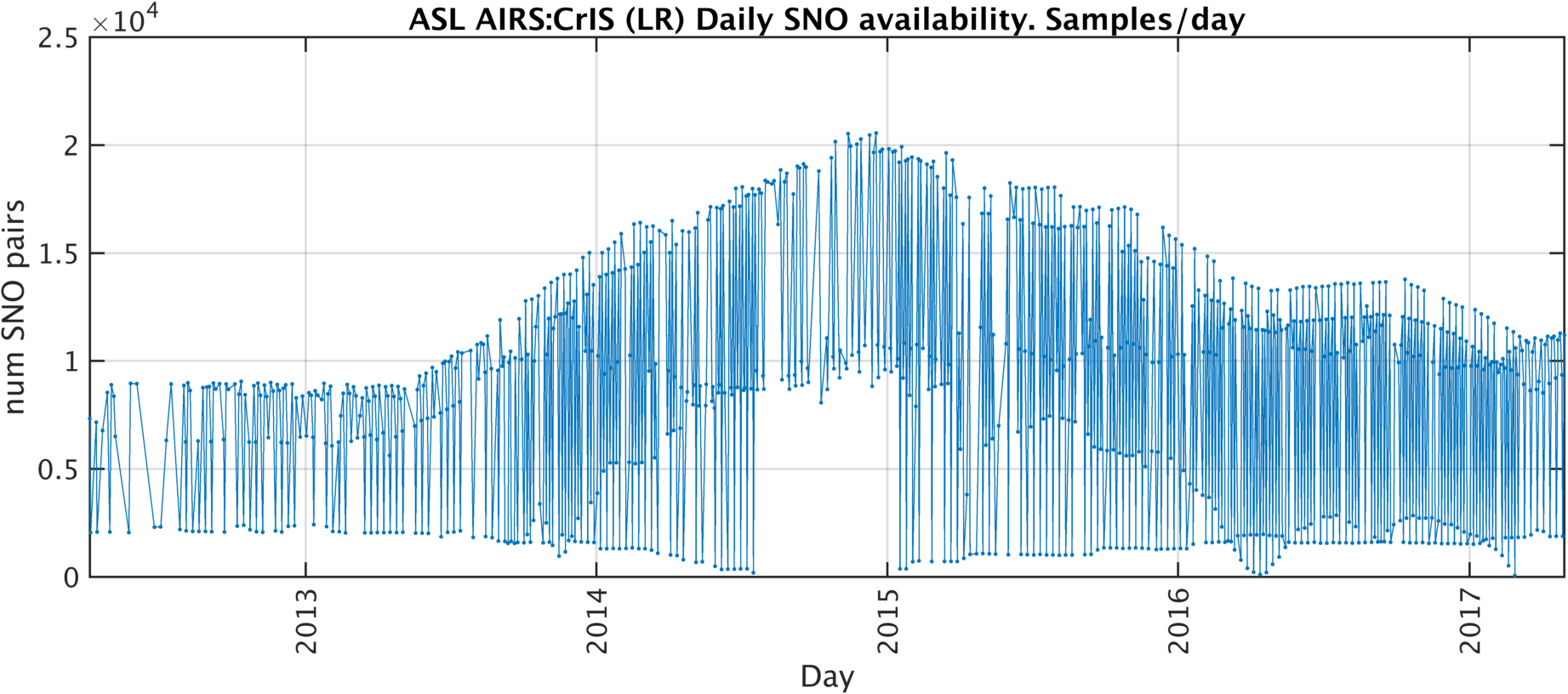AIRS:CrIS SNO
Thu, Aug 10, 2017
1 Root Location
/home/chepplew/projects/sno/airs_cris/
2 Overview
Some AIRS:CrIS SNO data ere available from JPL, the remainder are created at ASL.
4 Group Locations:
/asl/s1/chepplew/data/sno/airs_cris/JPL//asl/s1/chepplew/data/sno/airs_cris/ASL/There are two options in the ASL/ directory: Data from CrIS high-resolution mode or CrIS low-resolution mode:/asl/s1/chepplew/data/sno/airs_cris/ASL/HR//asl/s1/chepplew/data/sno/airs_cris//ASL/LR/File names will be of the form: sno_airs_cris1_asl_wngbr_20130116_frmL1c.mat
5 ASL data:
MAT files are supplied with the following fields:
| short name | contents | description |
| ---------–—: | :------------- | :--------------- |
| req_date: | '2013/01/16 ' | The date processed. |
| cris_res: | 'LOW' | CrIS spectral resolution |
| maxDtim: | 0.0069 | Maximum temporal separation of Obs (in units of day) |
| maxDphi: | 0.0719 | Maximum anglular separation of Obs (degrees of great circle) |
| cFnams: | {1x181 cell} | The Names of the CrIS granule files. |
| arDir: | 'asl/data/airs/L1C/2013/016' | Directory of AIRS granule files. |
| arLst: | [240x1 struct] | AIRS granule file listing. |
| upos: | [8408x2 double] | Indexes of pairs |
| sno: | [1x1 struct] | Geolocation data |
| nbr_ra: | [2645x2x8408 double] | AIRS neighbour radiances |
| nbr_rLW: | [717x4x8408 double] | CrIS neighbour radiances |
| ra: | [2645x8408 single] | AIRS SNO radiances |
| fa: | [2645x1 single] | AIRS channel (centre) frequencies. |
| rc: | [1317x8408 single] | CrIS SNO radiances |
| fc: | [1317x1 double] | CrIS channel (centre) frequencies. |
5.1 Production:
- step 1: Obtain SNO pairs, with neighbours and geolocation.
/home/chepplew/projects/sno/makeSNO/make_AIRS_CRIS_sno_frmL1c.m
In batch mode, use driver, configuration script:
/home/chepplew/projects/sno/makeSNO/drive_AIRS_CRIS_SNO_frmL1.m
which points to a file of list of dates to process in ./batchJobs/jobDates.drv and includes options to convert AIRS to CrIS spectral grid.
The slurm controller commands are in the batch shell script:
/home/chepplew/projects/sno/makeSNO/run_AIRS_CRIS_SNO_frmL1.sh
Execute at the shell command line as:
>sbatch –array=0-N run_AIRS_CRIS_SNO_frmL1.sh
Where N is the number of days to process in the jobDates.drv file minus 1
(the slurm array index starts at zero).
- step 2: Convert AIRS to CrIS ILS.
Can be used if the option in 1. was not used to do the spectral conversion.
/home/chepplew/projects/airs/AIRS2CRIS/ASL_AC_sno_airs2cris.mAccepts a single numeric input for the year of SNOs to process.
Appends new fields to existing SNO MAT file: ra2c, fa2c, opt(airs2cris options) - step 3. Apply drift correction to AIRS. ~chepplew/projects/airs/freqCal/airs_freq_shift_sno.m rund for requested SNO date: airs_freq)shift_sno(sdate). Can be run in batch script: run_airs_freq_shift_sno.m which is hard wired for year of SNO data. Calculates AIRS spectral drift correction to create new field, ra_shift, and translates this to the CrIS ILS. Appends new fields to existing SNO MAT file: ra_shift, ra2c_shift, fa2c_shift, shift_opt(airs2cris options)
5.2 Analysis:
Two matlab routines are provided for convenience:
asl_sno/source/load_sno_airs_cris_asl_mat.masl_sno/source/plot_sno_airs_cris_asl_mat.m
The load routine puts all the requested data into a single structre. The plot routine includes algortihms for computing quantiles and converts radiances to brightness temperature. It can also handle subsetting by day/night north/south hemispheres and the neighbour FOVs of the SNO samples, however these aspects are best handled manually i.e. at the command line in matlab.
5.3 Results
6 JPL data:
The JPL SNO data originate at JPL and consist IDPS CrIS data (of unknown heritage) and AIRS v5 level 1b radiances. Refer to JPL readme document: https:/asl.umbc.edu/pub/chepplew/asl_blog/project_docs/ReadmeGES_sPEATE_SNO_2014-02-27.pdf
At ASL the AIRS l1b data are converted to an interim level 1c using the SCAF (clean and fill) routines run at ASL. The resutling 2645 channel radiances are then converted to radainces on the CrIS ILS. Supporting dara contained in the SNO files includes diagnostics from the SCAF routine. Currently these diagnostics are not used further.
MAT files are supplied with the following fields. (NB. the time difference value is the absolute value so a new variable is evaluated by difference the AIRS and CrIS SNO observation times.
%
Field arrays:
ctime: [N x 1 double]
clat: [N x 1 single]
clon: [N x 1 single]
clandfrac: [N x 1 single]
csolzen: [N x 1 single]
cifov: [N x 1 int32]
rc: [1317 x N single]
atime: [N x 1 double]
alat: [N x 1 single]
alon: [N x 1 single]
alandfrac: [N x 1 single]
asolzen: [N x 1 single]
afindex: [N x 1 int32]
aatrack: [N x 1 int32]
axtrack: [N x 1 int32]
ra: [2378 x N single]
dist: [N x 1 single]
tdiff: [N x 1 single]
raScaf: [2645 x N single]
l1cProc: [2645 x N single]
l1cReas: [2645 x N single]
raDecon: [1185 X N single]
deconFrq: [1185 x 1 single]
deconOpt: [1Ã1 struct]
6.1 Processing
For convenience two routines are provided to load and analyize the JPL SNO data:
asl_sno/source/load_sno_airs_cris_jpl_mat.masl_sno/source/plot_sno_airs_cris_jpl_mat.m
The load routine puts the requested data into a single structure, and a basic quality control is applied. The plot routine also includes algorithms for computing the quatile dependencies and converts radiances to brightness temperature. The plotting section contains a wide variety of plots and should be used manually, i.e. in command line mode.
6.2 Results
Here results are given for the SNO set of 2013. It is instructive to compare these with the equivalent derived from the ASL 2013 SNO set.
JPL SNO Results Figure Viewer7 ENDING
…
